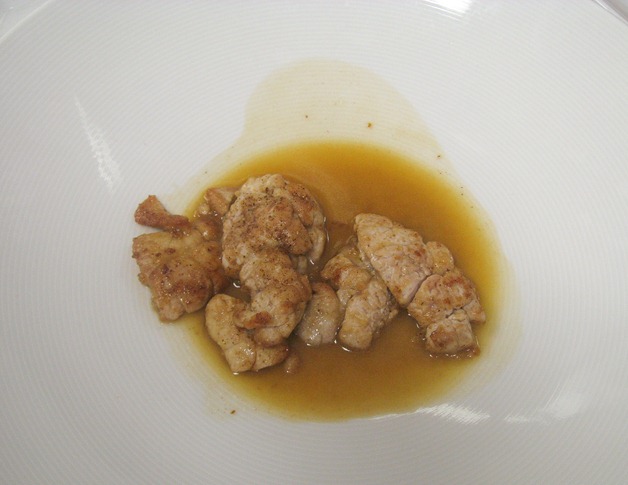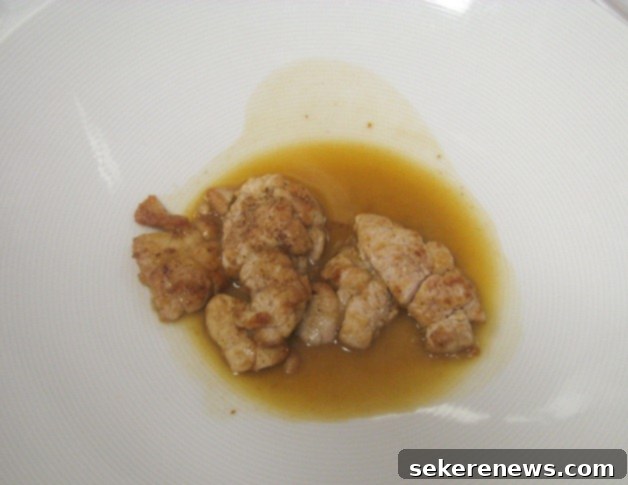Culinary Adventures: Week 19 – Mastering Seafood, Sweetbreads, and Raspberry Soufflé
Week 19 in culinary school proved to be an exciting departure from our usual routine, full of unique challenges and learning opportunities. With our esteemed Chef Patrice away conducting cooking demonstrations in Texas, the dynamic duo of Chef Michel and our diligent assistant, Allyson, took the reins. This shift in leadership, coupled with a compressed schedule of only two production days before a highly anticipated wine field trip and another demanding Market Basket challenge, promised a week packed with intensive learning and new experiences. It was a true test of adaptability and skill, pushing us to excel under different guidance and tighter deadlines, preparing us for the dynamic environment of a professional kitchen.

A Luxurious Start: Seafood Chowder in a Vol au Vent
Our culinary journey for the week commenced with a sophisticated first course: a rich and creamy seafood chowder, elegantly presented in a vol au vent. For those unfamiliar with this exquisite French pastry, a vol au vent is a delicate, hollow puff pastry case, perfectly designed to hold savory fillings. This unique presentation immediately elevated the dish beyond a simple bowl of soup, transforming it into a refined appetizer truly fit for a fine dining experience.
The undisputed stars of our chowder were an exquisite selection of fresh seafood: tender scallops, plump shrimp, and delicate salmon. We meticulously cut these pristine ingredients into small, uniform pieces to ensure even cooking and a pleasant, melt-in-your-mouth texture in every spoonful. The seafood was then quickly and expertly poached in a reduced fumet – a concentrated fish stock – which was thoughtfully flavored with finely diced shallots and a splash of aromatic vermouth. This careful poaching technique was crucial; it not only ensured the seafood remained succulent but also imparted a depth of flavor that a simple boil could never achieve.
Once the seafood reached its perfect doneness, we transitioned to crafting the velouté, a classic French mother sauce that would form the luxurious base of our chowder. This involved preparing a roux, a carefully balanced mixture of flour and butter cooked together, which served as the essential thickening agent. Rich cream was then slowly incorporated, creating a luxurious, velvety consistency that beautifully enveloped the perfectly cooked seafood. The resulting chowder was incredibly rich and indulgent, a true testament to classic French culinary techniques and the superior quality of our ingredients. Every spoonful was a symphony of delicate flavors and harmonious textures, making it a truly memorable and satisfying dish.
Confronting the Unfamiliar: The Sweetbreads Experience
Tuesday brought forth a new and somewhat daunting culinary challenge: preparing sweetbreads. This was a protein entirely new to my culinary repertoire, and I must confess, my initial enthusiasm was muted. The name itself is quite misleading; sweetbreads are far from sweet and bear absolutely no resemblance to bread. They are, in fact, an organ meat, specifically the thymus gland of veal or lamb. While I knew many gourmands cherish them as a delicacy, I approached this task with considerable skepticism, much like my previous encounter with calf’s liver in Phase I. Despite my personal reservations, I was committed to trying every dish we prepared in culinary school – a personal rule I had vowed to uphold since day one.

Understanding Sweetbreads: From Gland to Gourmet Delicacy
For those unfamiliar with sweetbreads, a little culinary education is in order. They are typically the thymus gland, most commonly sourced from young calves or lambs. While the pancreas can also be referred to as sweetbread, our focus in class was specifically on the thymus gland. Chefs primarily prefer sourcing them from young animals because the gland shrinks significantly with age, becoming less palatable. Preparing sweetbreads correctly is a multi-step process that begins with essential cleaning to remove any impurities. We started by soaking the glands in cold water, often for several hours and with multiple water changes, to draw out any residual blood. This is followed by a gentle poaching, usually in a flavorful liquid, which helps firm up the texture and make them easier to handle for further preparations. Visually, they possess a unique, somewhat irregular shape and an almost brain-like texture, which, I admit, doesn’t immediately inspire appetite for the uninitiated. However, the remarkable transformation they undergo during cooking is often what surprises diners.
Our primary preparation involved braising the sweetbreads, a classic slow-cooking method that tenderizes them beautifully and infuses them with deep, complex flavors. This rich, aromatic braise was then meticulously served alongside homemade spinach gnocchi, creating a harmonious and hearty dish. The combination was designed to balance the richness of the sweetbreads with the fresh, earthy notes of the gnocchi.
Crafting Spinach Gnocchi: A Classical Approach to a Beloved Dish
We’ve certainly experimented with various gnocchi recipes in Phase I, ranging from ricotta to semolina versions, but this week marked our first classical preparation using riced potato. This traditional method emphasizes achieving a light, ethereal texture. The addition of vibrant pureed spinach not only lent a beautiful green hue to the dough but also imparted a subtle, earthy flavor that complemented the overall dish. The process involves carefully ricing freshly cooked potatoes to achieve a fine, fluffy consistency, then gently mixing in the spinach puree, a precise amount of flour, and egg to form a pliable dough. The art lies in minimal handling to prevent a tough gnocchi. While my personal assessment of this particular batch was “okay”—not quite the best gnocchi I’ve ever tasted, lacking that ultimate pillowy softness—it was an invaluable lesson in the traditional method, emphasizing precision in potato preparation and dough handling, skills crucial for any aspiring chef.

The Pan-Fried Sweetbreads Taste Test: Overcoming Trepidation
To further our understanding and experience with sweetbreads, Chef Michel also demonstrated a more classical, simple preparation: pan-frying them to a golden crisp with a squeeze of fresh lemon juice. This minimalist approach is often favored as it allows the natural, subtle flavor and delicate texture of the sweetbreads to truly shine without being masked by heavy sauces. Despite my steadfast rule of trying everything, I approached this particular tasting with a definite sense of trepidation. The initial visual, combined with its unique origin as an organ meat, made it a significant mental hurdle to overcome.
My honest opinion? It was surprisingly not as unappealing as I had braced myself for. In fact, when perfectly pan-fried, the texture was remarkably similar to tender chicken, offering a satisfyingly delicate yet firm bite. However, about half a minute after the first bite, a distinct, slightly iron-y aftertaste emerged. It wasn’t overwhelmingly unpleasant, but it was enough to confirm that sweetbreads, while an intriguing and culturally significant culinary ingredient, might not become a personal favorite. Let’s just say I didn’t reach for a second helping for lunch, but I respected the experience and the valuable lesson learned in expanding my palate and my culinary courage.

A Sweet Ending: The Convenient Raspberry Soufflé
To conclude our challenging yet incredibly rewarding production days, we prepared a delightful raspberry soufflé for dessert. This particular soufflé recipe stood out from others we’d learned due to its unique base, which cleverly incorporates cornstarch as a key stabilizing agent. The base itself was a simple yet highly effective combination of rich egg yolks, fine granulated sugar, the distinguishing cornstarch, vibrant raspberry puree, and a small amount of lemon juice, added to brighten and balance the fruit flavors. This cornstarch-infused base is precisely what makes this soufflé method incredibly versatile and remarkably convenient.
To this rich, flavorful base, we carefully folded in meticulously whisked egg whites, which were expertly stabilized with a pinch of salt and a touch of cream of tartar. The cream of tartar plays a crucial role here, helping to achieve a more stable meringue, which in turn ensures the soufflé rises beautifully and holds its airy structure, preventing collapse. At this stage, a true innovation in soufflé preparation, we filled our individual ramekins with the soufflé mixture and placed them directly into the refrigerator. This ability to prepare the soufflé ahead of time, holding it perfectly until it’s ready to be baked, is an absolute game-changer in professional and home kitchens alike. Unlike traditional soufflés that demand last-minute whisking and folding of delicate egg whites, this method offers unparalleled convenience for entertaining, allowing hosts to focus on their guests rather than frantic kitchen work.
This “make-ahead” soufflé is a fantastic dinner party idea, eliminating the stress of precise timing and ensuring a perfectly risen, impressive dessert every single time. It offers the same elegant presentation, the delightful airy texture, and the rich, complex flavors as a regular soufflé but with significantly less last-minute fuss and a much higher guarantee of success. The vibrant tartness of the raspberry puree, combined with the sweet, ethereal lightness of the soufflé, created a perfect balance of taste and texture, leaving a lasting impression of culinary finesse.

Beyond the Kitchen: Stages, Externships, and Winery Visits
Overall, it was an incredibly interesting, challenging, and profoundly educational menu to prepare. Despite leaving school feeling a bit hungry (the sweetbreads, while an experience, didn’t quite fill me up!), the culinary lessons gained were immense. Luckily, I managed to grab a quick snack at home before heading out for my fourth—and most likely, final—stage at a bustling, high-end restaurant in downtown DC. These stages have been an integral and invaluable part of my culinary training, offering crucial real-world experience that complements our classroom learning. I spent a demanding evening from about 6 PM to 9:15 PM immersed in the restaurant’s dynamic environment, gaining first-hand insights into the fast-paced operations and precise standards of a professional kitchen before returning home to prepare for the next day’s adventures and studies.
I’m now on the cusp of making my final decision regarding my upcoming externship, a major milestone in my culinary journey. I’ll be sharing more exciting details about this next chapter over the coming week or two, as soon as my decision is finalized. The suspense will finally end, and I’ll be able to proudly disclose the locations of all these incredible stages that have so significantly shaped my burgeoning culinary path!
Before that, however, we have a delightful and much-anticipated break from the intensity of school. Tomorrow, our entire class is embarking on a highly anticipated field trip to Boxwood Winery in Middleburg, VA. I’m already looking forward to capturing the picturesque beauty of the vineyards and gaining a deeper understanding of the winemaking process with my good camera, eager to combine my love for photography with my growing passion for food and drink. This week truly underscored the diverse and ever-evolving nature of culinary arts, blending rigorous practical kitchen skills with invaluable experiential learning opportunities both inside and beyond the classroom.
